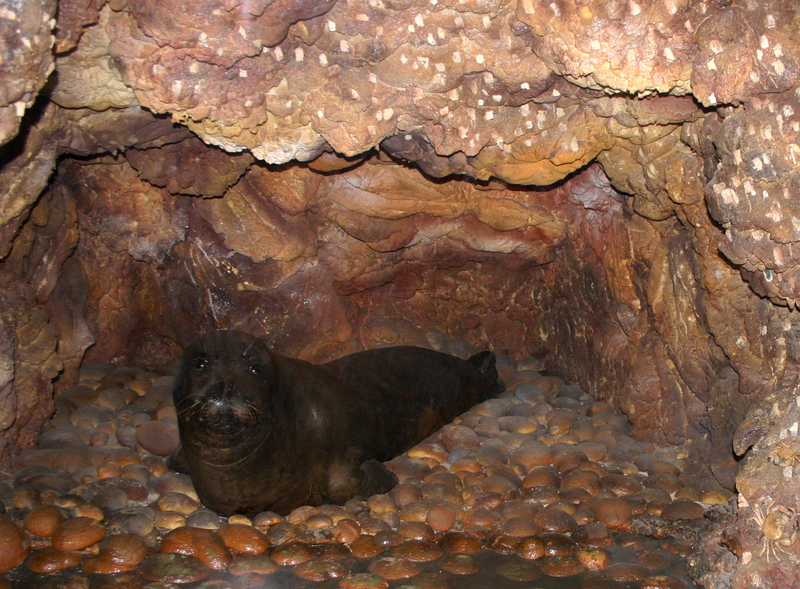|
| Query: cape fur seal | Result: 8th of 22 | |
Mediterranean Monk Seal (Monachus monachus) - Wiki
| Subject: | Mediterranean Monk Seal (Monachus monachus) - Wiki
| |

| Resolution: 1367x1006
File Size: 1406570 Bytes
Upload Date: 2007:12:21 11:41:51
|
Mediterranean Monk Seal
From Wikipedia, the free encyclopedia
Order: Carnivora
Suborder: Pinnipedia
Family: Phocidae
[Photo] The Natural history museum in Milan, Italy. Diorama with a Monachus monachus (Mediterranean Monk seal). Picture by Giovanni Dall'Orto (http://commons.wikimedia.org/wiki/User:G.dallorto), April 22 2007.
The Mediterranean Monk Seal (Monachus monachus) is believed to be the world's rarest pinniped and one of the most endangered mammals of the world.
Description
This species of monk seal grows from approximately 80 cm long at birth to an average of 2.40 m in adults. The latter weigh up to 320 kg, the females being slightly smaller than the males. Their fur is black (males) or brown to dark grey (females) with a paler belly which is close to white in males. Pups are mostly born in autumn, entering the water two weeks afterwards, and are weaned at around 18 weeks of age. They are born with black natal fur, often with a white patch beneath. The shape of these patches can be used to identify individuals. Reproductive maturity is reached at around age four, and maximum age is over twenty years. Pregnant Mediterranean Monk Seals typically use inaccessible undersea caves while giving birth, though historical descriptions show that they used open beaches until the eighteenth century.
The Mediterranean Monk Seals are diurnal and feed on fish and mollusks, primarily octopus, up to 3 kg per day.
Status
This earless seal's former range extended throughout the Mediterranean Sea and Black Sea coasts line and into the Atlantic, as far South as Cape Verde (where it is now extinct) and as far West as the Azores (where it is also extinct as a breeder but there are occasional sightings of mavericks coming from the Desertas population).
Several causes have provoked a dramatic population decrease over the time, mostly commercial hunting (especially during the Roman Empire and Middle Age) and, during the 20th century, eradication by fishermen ??? who used to consider it a pest due to the damages the seal causes to fishing nets when it preys on fishes caught in those ??? and coastal urbanisation.
The species has gone extinct in the Sea of Marmara, due to pollution and heavy ship traffic from the Dardanelles and the Bosphorus. In addition, the last report of a seal in Black Sea dates to late 1990s.
Nowadays its entire population is estimated to be nowadays less than 600 individuals scattered throughout a wide distribution range, which qualifies this species as Critically Endangered. Its current very sparse population is one more serious threat to the species, as it only has two key sites which can be deemed viable: the Aegean Sea and, specially, the one in the Western Sahara portion of Cabo Blanco (which may support the small but growing nucleus in the Desertas Islands). These two key sites for the species are virtually in the extreme opposites of its distribution range, which makes natural population interchange impossible.
In the summer of 1997, two thirds of the largest surviving single population of Mediterranean monk seals (the one in Cabo Blanco) was wiped out within the space of two months, extremely compromising the species' viable population. While opinions on the precise causes of this epidemic remain sharply divided (the most likely cause being either a morbilivirus or a toxic algae bloom) the mass die-off emphasised the precarious status of a species already regarded as critically endangered throughout its range. While still far below the beginning of 1997, numbers in this all important location have started a slow paced recovery ever since. Currently the population in this location is estimated at 150 individuals, down from approximately 300 in 1997 but still the largest colony by far. The threat of a similar incident that could wipe out this entire population remains.
Preservation
Damage inflicted upon fishermen's nets and rare attacks on off-shore fish farms in Turkey and Greece are known to have pushed local people towards hunting the Mediterranean monk seal, but mostly out of revenge rather than population control. Preservation efforts have been put forth by civic organizations, foundations and universities in both countries since as early as the 1970s. For the past 10 years, many groups have carried out missions to educate locals on damage control and species preservation. Reports of positive results of such efforts exist throughout the area.
One of the largest groups among the foundations concentrating their efforts towards the preservation of the Mediterranean monk seal is the Mediterranean Seal Research Group (tr. Akdeniz Foklarını Ara??tırma Grubu) operating under the Underwater Research Foundation (tr. Sualtı Ara??tırmaları Derne??i) in Turkey (aka. SAD-AFAG). The group has taken initiative in joint preservation efforts together with the Fo??a municipal officials, as well as phone, fax and email hotlines for sightings.
Preservation of the species requires both the preservation of land and sea, due to the need for terrestrial haul-out sites and caves or caverns for the animal to rest and reproduce. Even though responsible SCUBA instructors hesitate to make trips to known seal caves, just the rumor of a seal sighting quickly becomes a tourist attraction for many. Irresponsible SCUBA trips shy the Mediterranean monk seal away from caves of potential habitation spots for the species.
http://en.wikipedia.org/wiki/Mediterranean_Monk_Seal
| The text in this page is based on the copyrighted Wikipedia article shown in above URL. It is used under the GNU Free Documentation License. You may redistribute it, verbatim or modified, providing that you comply with the terms of the GFDL. |
|
Comments |
|---|
| | Guest |
|
Scientific Name: Monachus monachus (Hermann, 1779)
Common Names: Mediterranean Monk Seal; [French] Phoque-moine Méditerranéen; [Spanish] Foca Monje
Synonyms: Phoca monachus Hermann, 1779 |
^o^
Animal Pictures Archive for smart phones
^o^
|
|
|